HEAT TRANSFER
- GOAL:
- To better understand human comfort inside the home or work place.
- OBJECTIVE:
- To know the three basic methods of heat transmission and how they will flow through walls, floors, ceilings, windows and doors.
- LESSON/INFORMATION:
- Heat seeks a balance with surrounding areas. When the inside temperature is controlled for human comfort, there will be some movement of heat. Heat moves from the inside to the outside during the winter and from the outside to the inside during the hot summer weather.
- For heat transfer to occur between two mediums, one medium must contain more heat. Heat always moves from the warmer medium to the cooler medium. Heat is also transferred at a rate directly related to the difference in temperature, and the resistance to heat flow provided by the materials between the two mediums. The transfer of heat takes place by one or more of three methods -- conduction, convection and radiation. (Fig. 1)
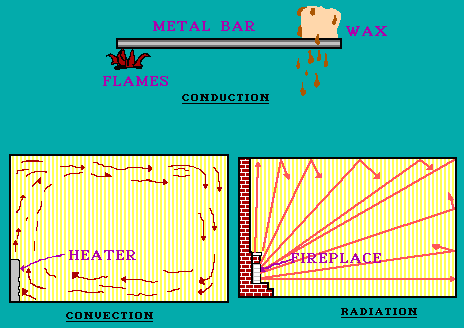
- Figure 1
- Conduction -
- Transmission of heat from one molecule to another within a given material or from one material to another when they are in direct contact. Dense materials like metal or glass conduct heat more rapidly than porous materials like wood or fiber products. Any material will conduct some heat when a temperature difference exists.
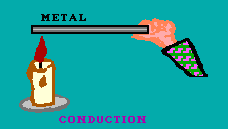
- Convection -
- Convective heat travels through a fluid. Molecules of a gas (air) or a liquid (water) become less dense and lighter when heated and rise. As the warmer molecules rise, the cooler ones sink to create convection currents.

- Radiation -
- Radiant heat transfer takes place without a medium. Radiant energy, transmitted as electromagnetic waves, travels at the speed of light until absorbed by a solid or reflected. The waves do not heat the space through which they pass. Effective resistance to radiation is attained with reflective surfaces like aluminum foil.
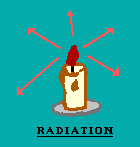
- Actually, heat transmission through the walls, floors, ceilings, windows and doors will be a result of all three of the methods operating in various degrees.
- ACTIVITY 1:
- Identify the action in the following pictures as one of the three types of heat transfer explained above. Then give examples of how materials in and around the home transfer heat in this manner.
- 1.
- Identify __________________________
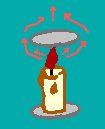
- Examples
- __________________________
- __________________________
- 2.
- Identify __________________________

- Examples
- __________________________
- __________________________
- 3.
- Identify __________________________
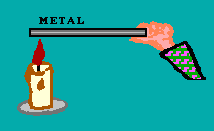
- Examples
- __________________________
- __________________________
- RESOURCES:
- W. Wagner, Modern Carpentry, Goodheart-Wilcox, South Holland, IL, 1969.
- E. Cazayoux, A. Hebert and D. Winn, Natural Louisiana Architecture, Louisiana Dept. of Natural Resources, Baton Rouge, LA, 1991.
Comments or questions to: TechAsmt@LA.GOV
Return to Comfort Menu










